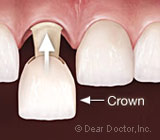Five Facts About Crowns
 A crown is a common type of dental restoration that has been available, in different forms, for a long while. When properly done, it may last for decades — and if desired, it can be made to match the shade of the natural teeth so well that it’s nearly impossible to tell them apart. Some recent technological innovations may offer patients who need this treatment even more choices. To begin learning about dental crowns, let’s start with five facts everyone should know.
A crown is a common type of dental restoration that has been available, in different forms, for a long while. When properly done, it may last for decades — and if desired, it can be made to match the shade of the natural teeth so well that it’s nearly impossible to tell them apart. Some recent technological innovations may offer patients who need this treatment even more choices. To begin learning about dental crowns, let’s start with five facts everyone should know.
Crowns are a type of restoration that can solve many dental problems.
There are many factors that may cause the structure of a tooth to become compromised. It can be weakened by grinding or chipping, gradually removed by repeated dental fillings, or suddenly broken by trauma. Sometimes, a more conservative treatment (like inlays or veneers) may be enough to take care of the problem. When it isn’t, the missing tooth structure can be replaced by a crown.
Crowns replicate the form and function of natural teeth.
Because they must fit into your mouth perfectly and match your bite exactly, each crown is an individually-crafted item, made just for you. That means the form of a crown must look just like the tooth it replaces — before it was damaged. And, especially if it’s for a front tooth, a crown is often carefully designed to match the particular shade of your teeth. If you are unhappy about the color of your other front teeth, tooth whitening should be done first before your new crown is created to get the best results possible.
Crowns can be made of different materials.
For over a hundred years, crowns have been made of gold. While this extremely long-lasting material remains popular, its use has been declining recently due to aesthetic factors. Two tooth-colored alternatives are all-porcelain and porcelain-fused-to-metal crowns. The exact shade and luster of these substances can be made to closely simulate the natural teeth. Each has advantages and disadvantages in particular situations but we will be happy to make recommendations as to what is in your best interests.
New technologies are changing the way crowns are prepared.
Advances in the field of materials science have led to crowns being fabricated from more durable high-tech substances, like ceramics made of zirconium dioxide. And the availability of small-scale computer-aided design and manufacturing technologies means that in some situations, it’s possible for a crown to be fabricated right in the dental office, in minutes. Undoubtedly, these technologies will continue to improve in the future.
Delivering a quality crown is a blend of science and art.
No matter how high-tech the process becomes, producing a fully functional, long lasting and natural-looking crown remains a blend of aesthetics and science, seasoned with a healthy dose of clinical experience. It’s also a team effort involving a skillful dentist, a talented dental laboratory technician and a knowledgeable patient — you.
If you would like more information about crowns, please contact Dr. Cindy Sumarauw at 801-281-3500 to schedule an appointment for a consultation. You can also learn more about this topic by reading the Dear Doctor magazine articles “Porcelain Crowns & Veneers,” “Gold or Porcelain Crowns,” and “Creating In-Office Dental Restorations With Computers.”


Leave a Reply